How to Clean Ceramic Planters and Improve Their Lifespan?
Time of issue: 2025-11-17 11:58:28- Essential Tools to Clean Ceramic Planters
- How to Clean Ceramic Planters? A Complete Step-by-Step Care Guide
- What Not to Do When Cleaning Ceramic Planters?
- How to Improve Drainage in Ceramic Planters?
- How Often Should You Clean Ceramic Planters?
- Seasonal Maintenance Tips for Ceramic Planters
- In Closing
- Frequently Asked Questions

Ceramic planters look elegant, but they collect soil residue, mineral crust, and algae faster than most growers expect. You notice this each time the pot loses its color or shows white rings along the inner wall. These signs tell you the planter needs a precise cleaning method, not random scrubbing.
But how to clean ceramic planters?
You clean ceramic planters by removing soil, scrubbing with mild cleaners, dissolving mineral crust, rinsing with warm water, and drying the pot fully so the clay stays stable and ready for planting.
At this point, it matters where your planter comes from. Dongsheng Ceramic has crafted high-quality ceramic products with advanced slip-casting, bisque firing, glazing, and strict inspection systems. With over 200 skilled production workers and full global audit approvals, the company produces durable planters with stable clay bodies, consistent glazing.
Essential Tools to Clean Ceramic Planters
Cleaning ceramic planters demands specific tools because each stain forms differently. You use these tools to break mineral crust, remove compacted soil, and clean the surface without causing scratches.
| Tool | Description |
| Nylon Scrub Brush | Removes loose soil and root film without marking glazed or unglazed ceramic. |
| Soft-Bristle Toothbrush | Reaches tight corners and lifts debris around rims and drainage points. |
| Plastic Scraper | Breaks dried soil rings and compacted debris without chipping the pot surface. |
| Microfiber Cloth | Wipes moisture and residue without leaving fibers on porous clay. |
| Mild Dish Soap | Cuts organic dirt such as algae film, plant sap, and root slime. |
| Warm Water Bucket | Softens soil layers and loosens debris before scrubbing. |
| Stiff Wooden Stick or Chopstick | Dislodges stuck roots from seams and interior curves without harming glazing. |
| Rubber Gloves | Protects your hands from dirt, organic residue, and bacteria in old soil. |
| Drainage Screen or Mesh Piece | Catches debris during rinsing and keeps bits from entering drains. |
How to Clean Ceramic Planters? A Complete Step-by-Step Care Guide
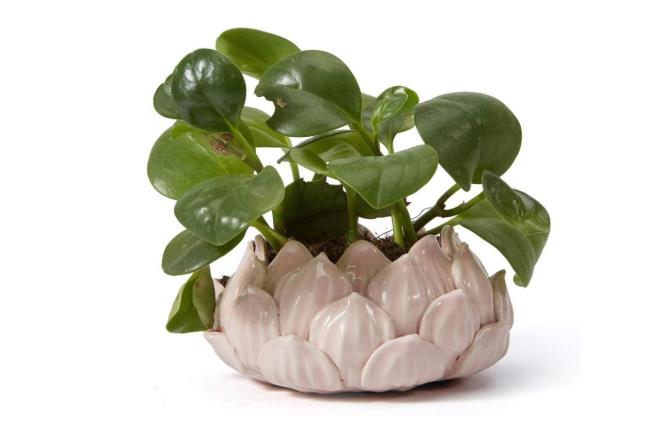
Ceramic planters collect soil residue, algae film, and mineral traces over time. You clean them with a precise sequence that removes buildup fast and protects both glazed and unglazed surfaces.
Cleaning Glazed Ceramic Planters
Step 1: Rinse Surface Dirt

Start by rinsing the glazed planter with warm water so you can clear loose dirt from the slick coating. As the water runs, you can easily release soil patches that cling to the glossy surface. This way, you will get a clean starting point and set up the soap application in the next step.
Step 2: Apply Mild Soap

Spread mild dish soap across the glazed walls because this bonds with algae film and organic residue that collect on the non-porous coating. As you coat each section, you soften surface grime. This prepares the planter for the controlled scrubbing you will do next.
Step 3: Scrub with Brush

Scrub the glazed surface using a nylon brush and steady circular strokes so you break down residue without scratching the glossy layer. As you move across the curves, you expose smaller buildup zones that hide near the edges. These points become your focus in the next detailing step.
Step 4: Detail Rim Areas
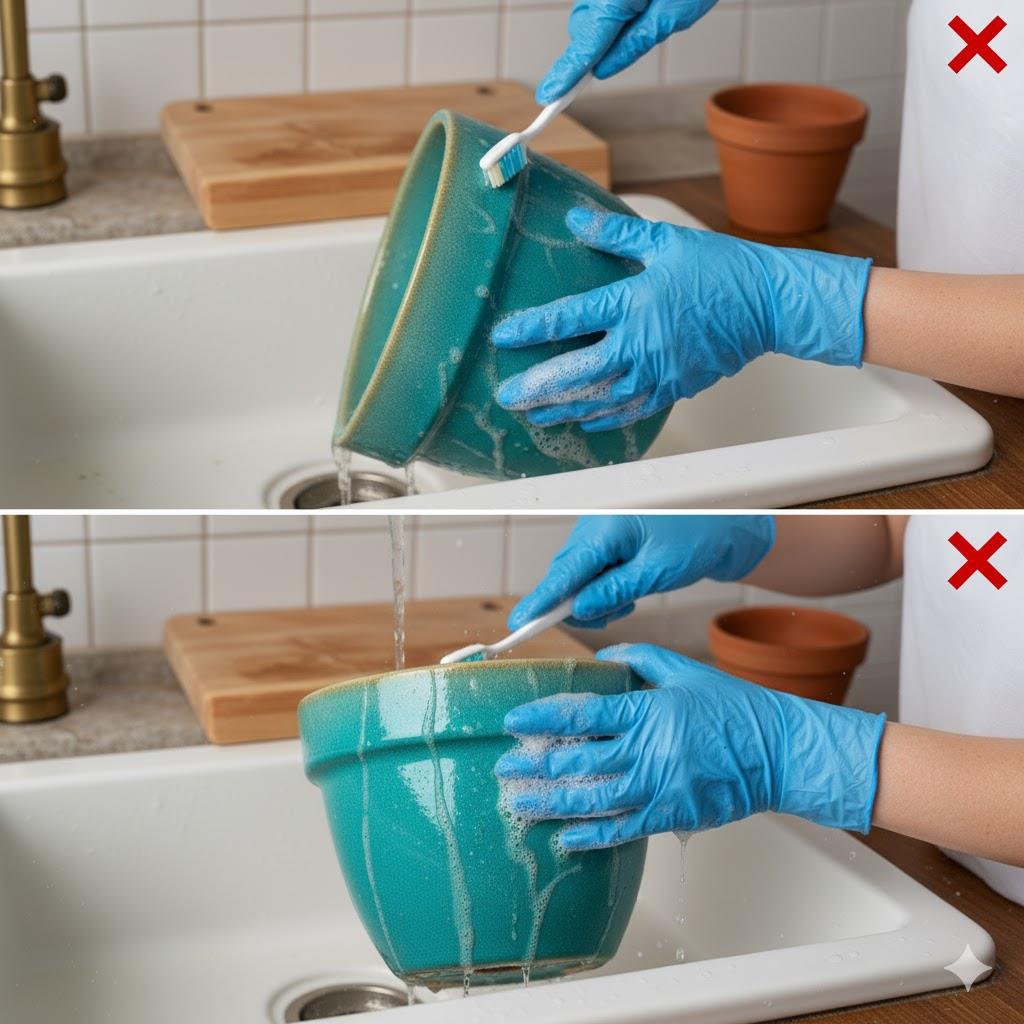
Switch to a toothbrush for the glazed rim and drainage edge because these areas trap compacted debris. As you work along the curves, you clear particles that the larger brush cannot reach. This gives the entire glazed surface an even finish before you rinse it again.
Step 5: Rinse Off Residue

Rinse the glazed planter thoroughly with warm water so you clear soap traces and loosen particles. As the water runs clean, you restore the smooth feel of the coating. This sets the stage for the final drying step, which protects the glaze from mineral marks.
Step 6: Dry with Cloth

Dry the glazed planter with a microfiber cloth because standing water creates spots on shiny ceramic. As you wipe each section, you expose any missed marks that you can fix instantly. This completes the process and leaves the glazed surface ready for planting.
Cleaning Unglazed Ceramic Planters
Unglazed ceramic absorbs minerals, soil residue, and moisture through its porous walls, so you clean it with a deeper process that clears internal deposits and restores the raw clay texture.
Step 1: Rinse to Prime the Clay Surface
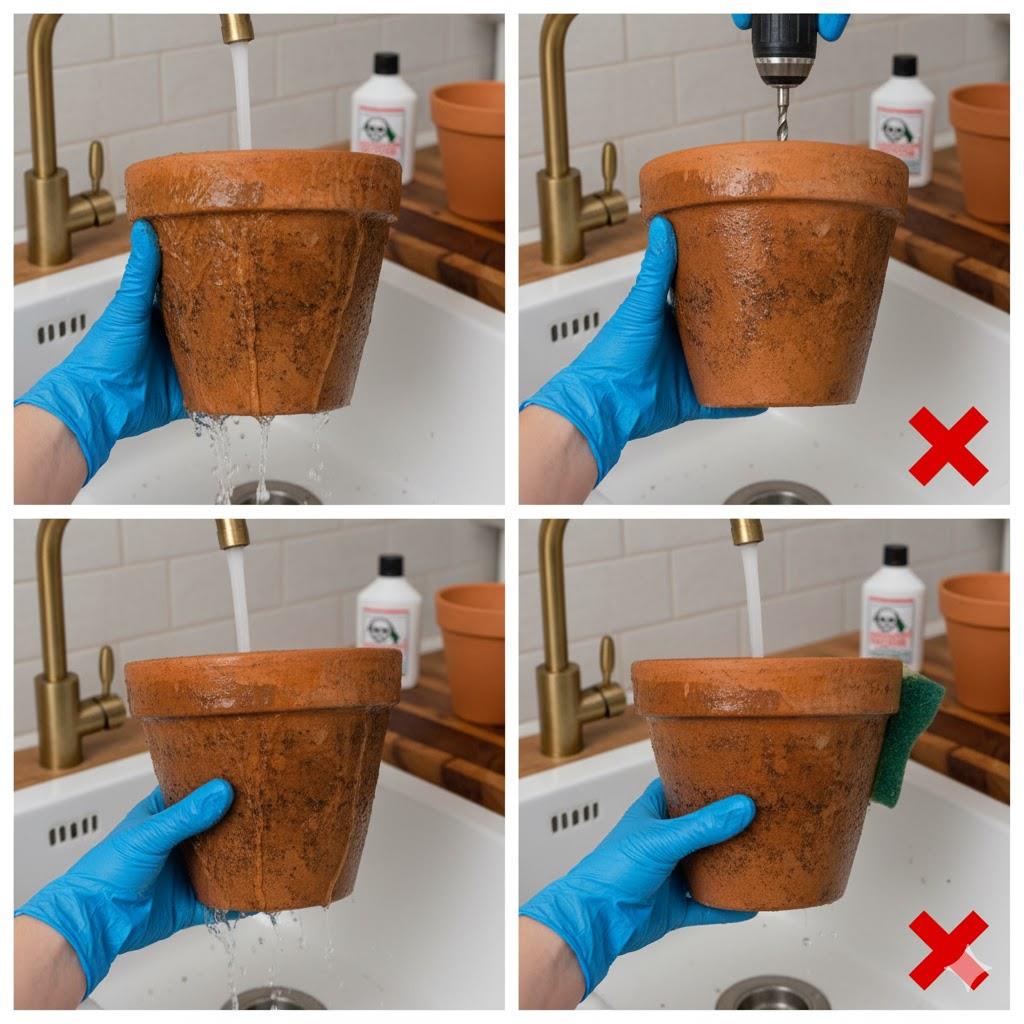
Start by rinsing the unglazed planter with warm water so you soften compacted dirt and hydrate the clay pores. As the surface becomes damp, soil fragments release from the walls. This primes the pot for the vinegar solution you will prepare next.
Step 2: Prepare a Water–Vinegar Solution
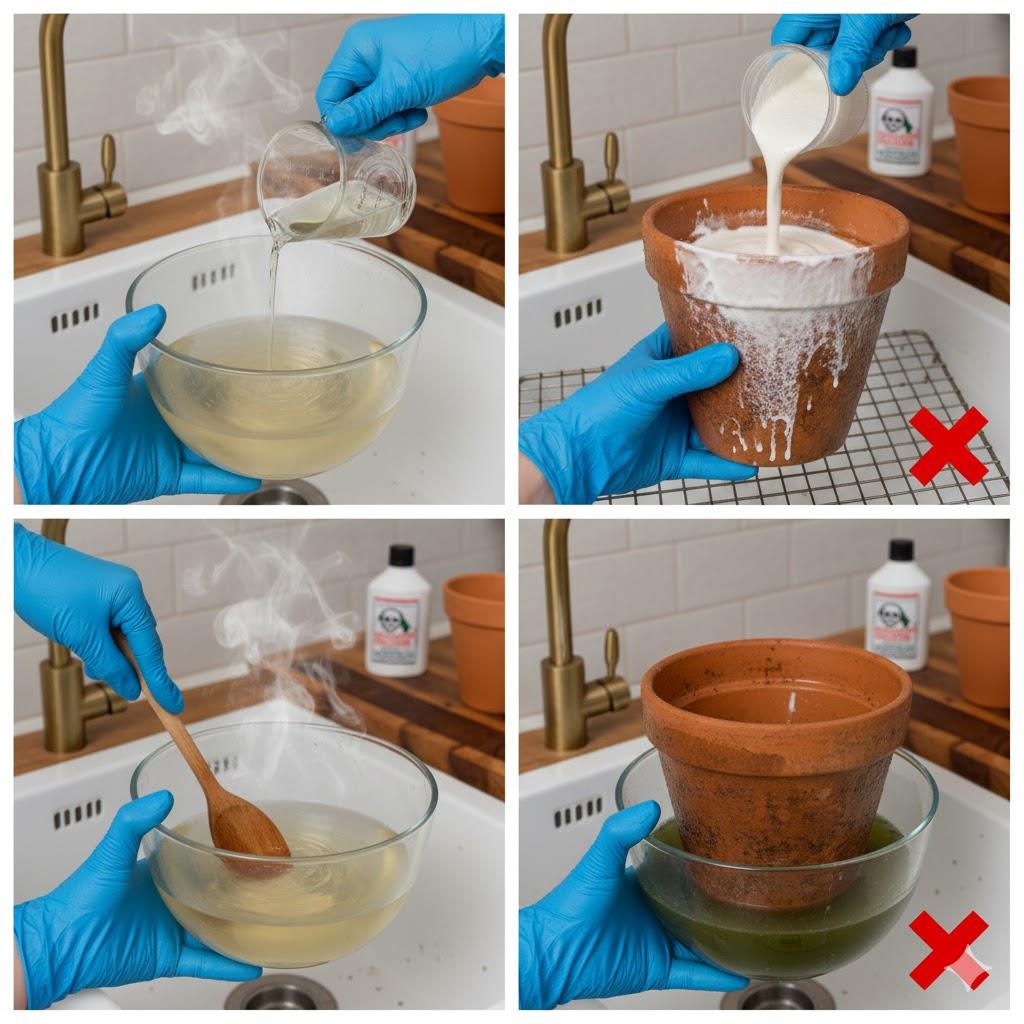
Mix four cups of warm water with one cup of white vinegar because this ratio dissolves calcium, magnesium, and salt trapped in porous clay. As you stir the solution, you create a consistent bath that penetrates deeper deposits. This gives you the right base for the scrubbing step that follows next.
Step 3: Scrub the Clay Surface Thoroughly

Place the unglazed planter in the vinegar solution and scrub with a nylon brush so you remove dirt embedded inside the pores. As you work across the surface, you expose mineral spots that resist quick cleaning. These areas transition directly into the soaking step, which breaks them down further.
Step 4: Soak to Break Mineral and Mold Build-Up
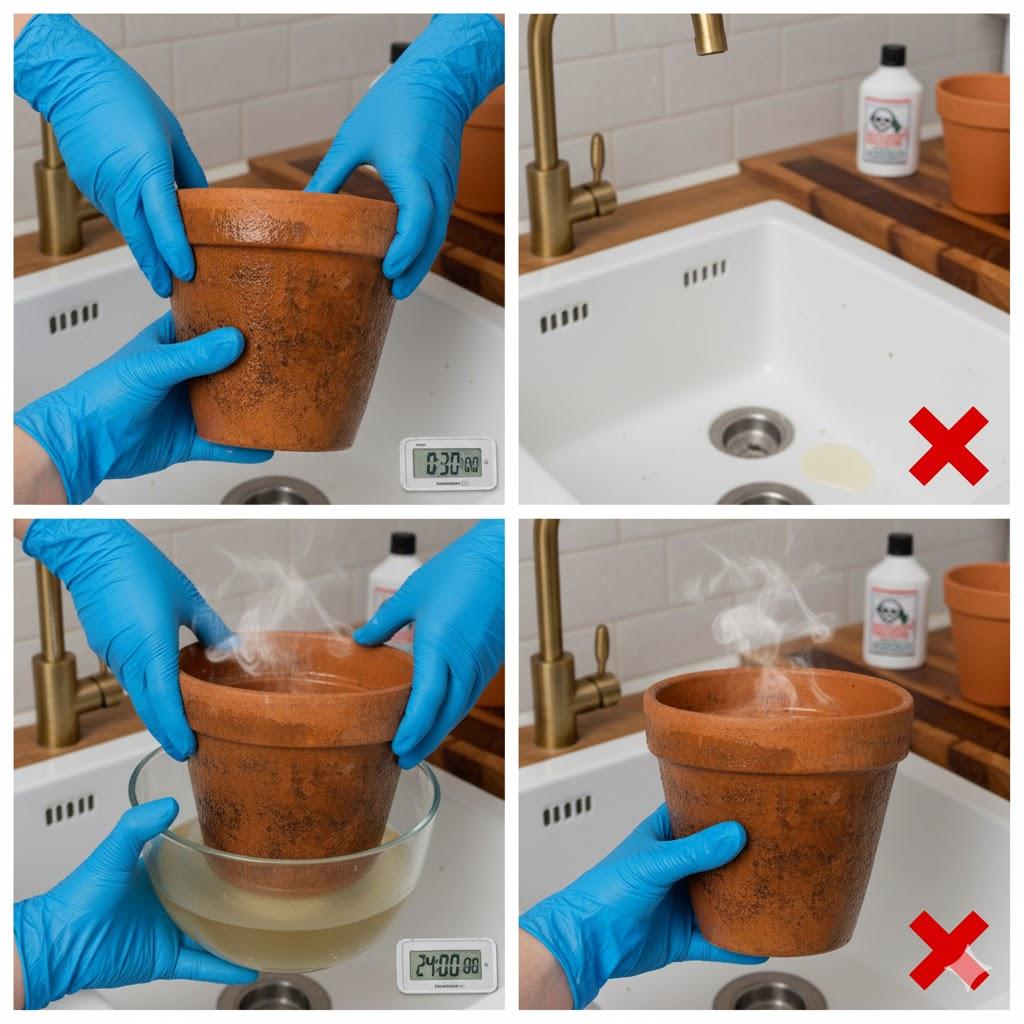
Keep the planter submerged for thirty minutes because the vinegar absorbs into the clay and reacts with salt crust, mold, and bacteria. As the clay sits in the solution, stubborn patches soften and release. This creates a cleaner surface that you rinse in the next step.
Step 5: Rinse to Clear Vinegar and Loose Particles
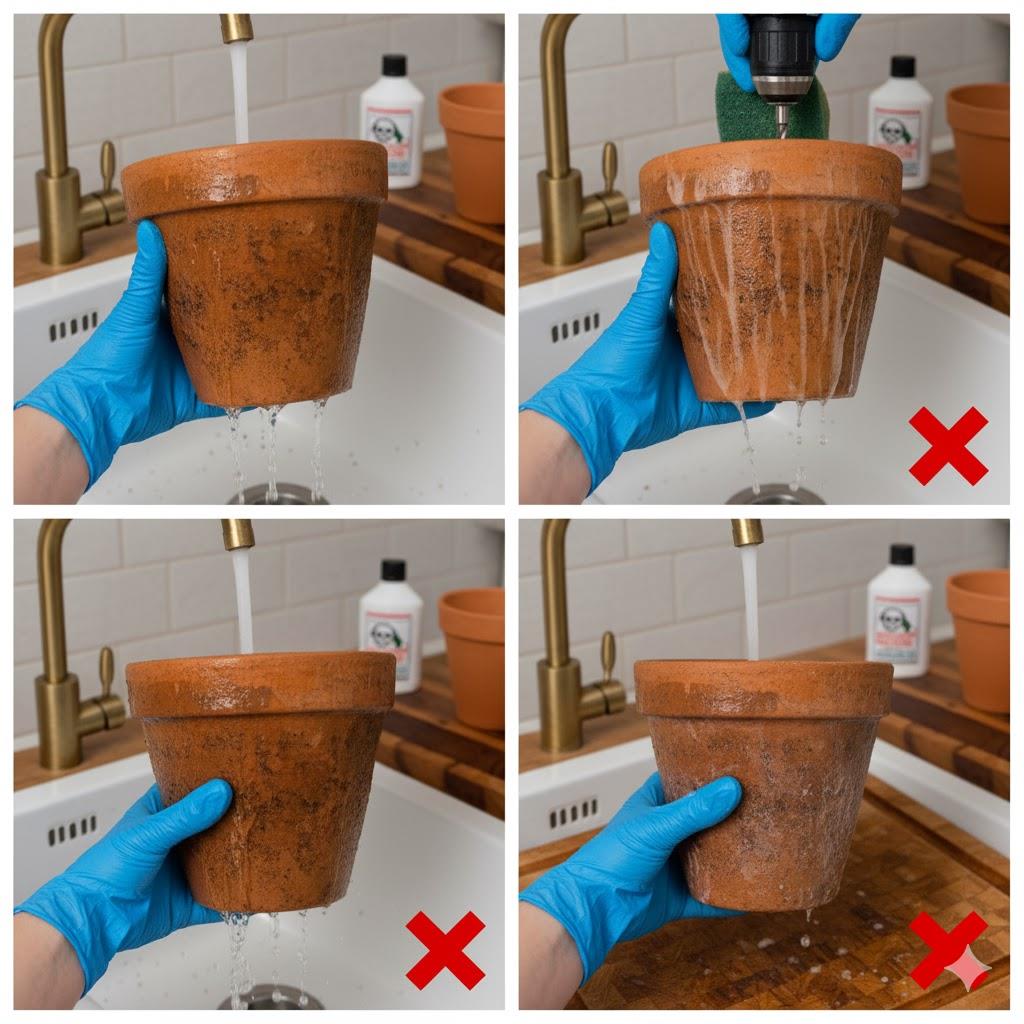
Rinse the planter with plain warm water so you flush away vinegar, scrub residue, and released mineral grains. As the water runs clear, the clay shows a more uniform tone. This prepares the pot for the long drying step that stabilizes the material.
Step 6: Dry for Full Moisture Release
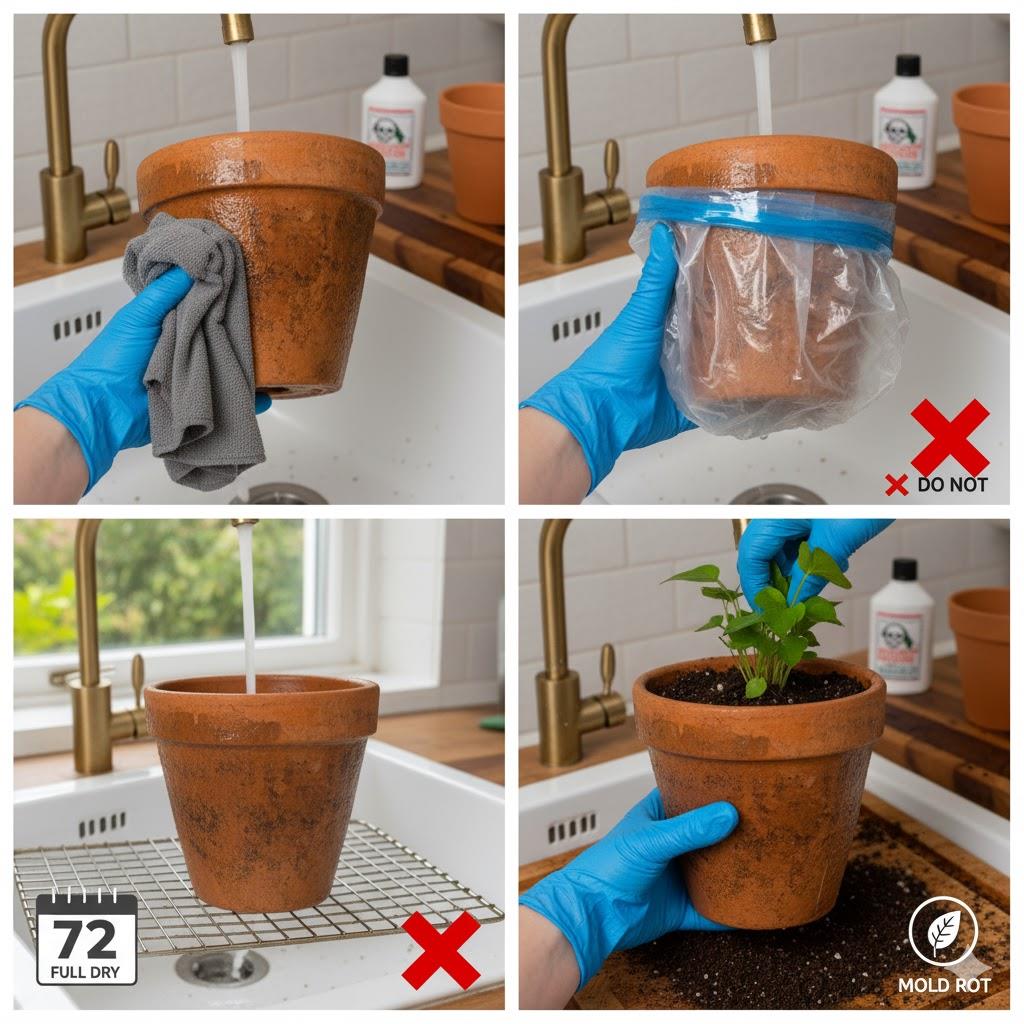
Dry the unglazed planter with a microfiber cloth and then place it in a ventilated space. Unglazed clay holds water deep inside, so this drying stage removes moisture stored in the walls. As the pot dries fully, the surface becomes firm and ready for planting without mold risk.
How to Clean Tough Stains and Mineral Deposits from Ceramic Planters
Tough stains form when minerals, algae, and salts bond to ceramic surfaces. You remove them with targeted methods that dissolve buildup, break hardened layers, and clear deep discoloration inside glazed and unglazed planters.
Method 1: Vinegar and water solution
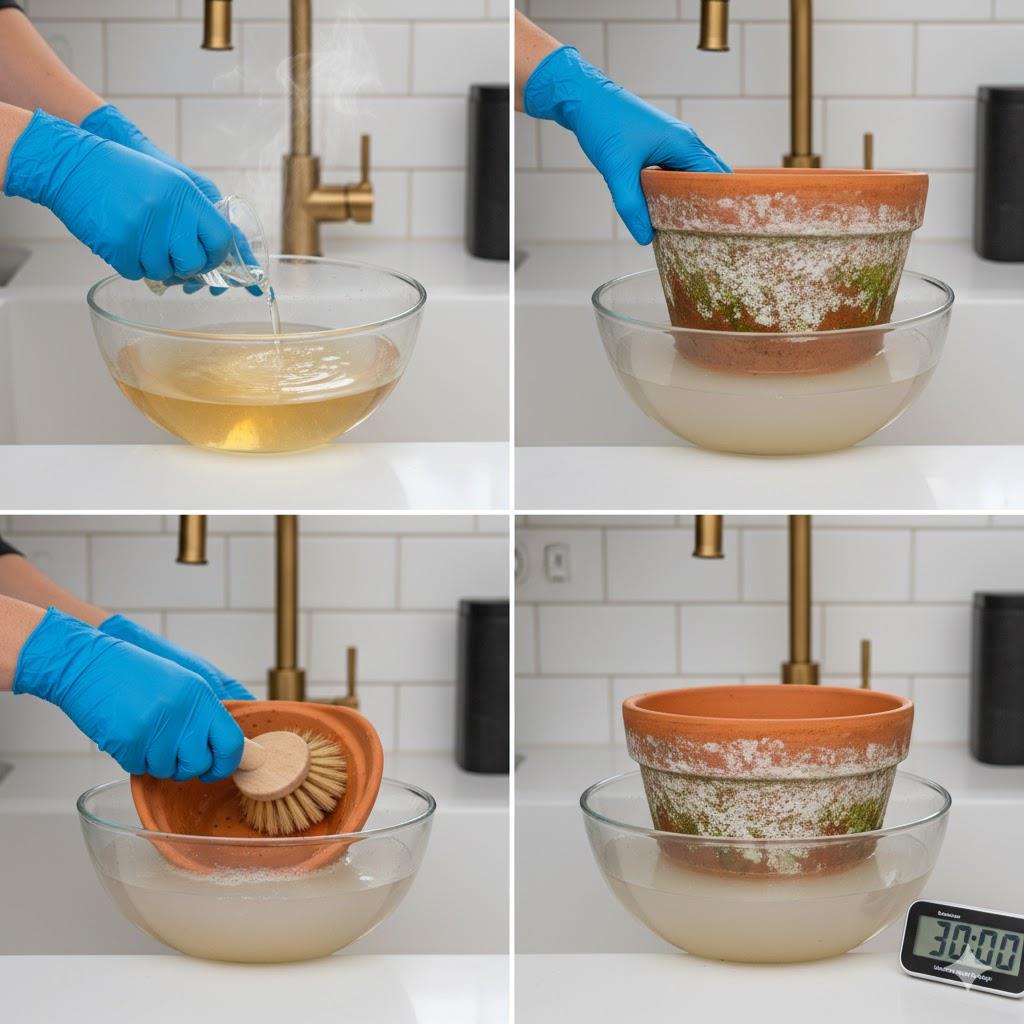
With this method, you can effectively target and clean the mineral crust and salt buildup that bond deep inside ceramic walls.
- Mix equal parts solution: Combine equal parts warm water and white vinegar. This balanced mix breaks calcium, magnesium, and salt deposits without stressing the ceramic structure.
- Submerge the planter fully: Place the pot in the solution so the liquid reaches pores and surface gaps. This contact softens hardened mineral layers fast.
- Scrub the surface immediately: Use a nylon brush and work in circular strokes. This action removes loosened deposits before they settle back into the clay.
- Soak for stubborn buildup: Leave the planter in the solution for thirty minutes. This soaking phase weakens deeper mineral crust and light mold patches.
- Inspect and scrub again: Lift the pot and check darker spots. Work these areas again because they hold a heavier salt concentration.
- Rinse with plain warm water: Clear all vinegar traces to avoid streaks and stop acidic residue from drying on the surface.
Method 2: Baking soda paste
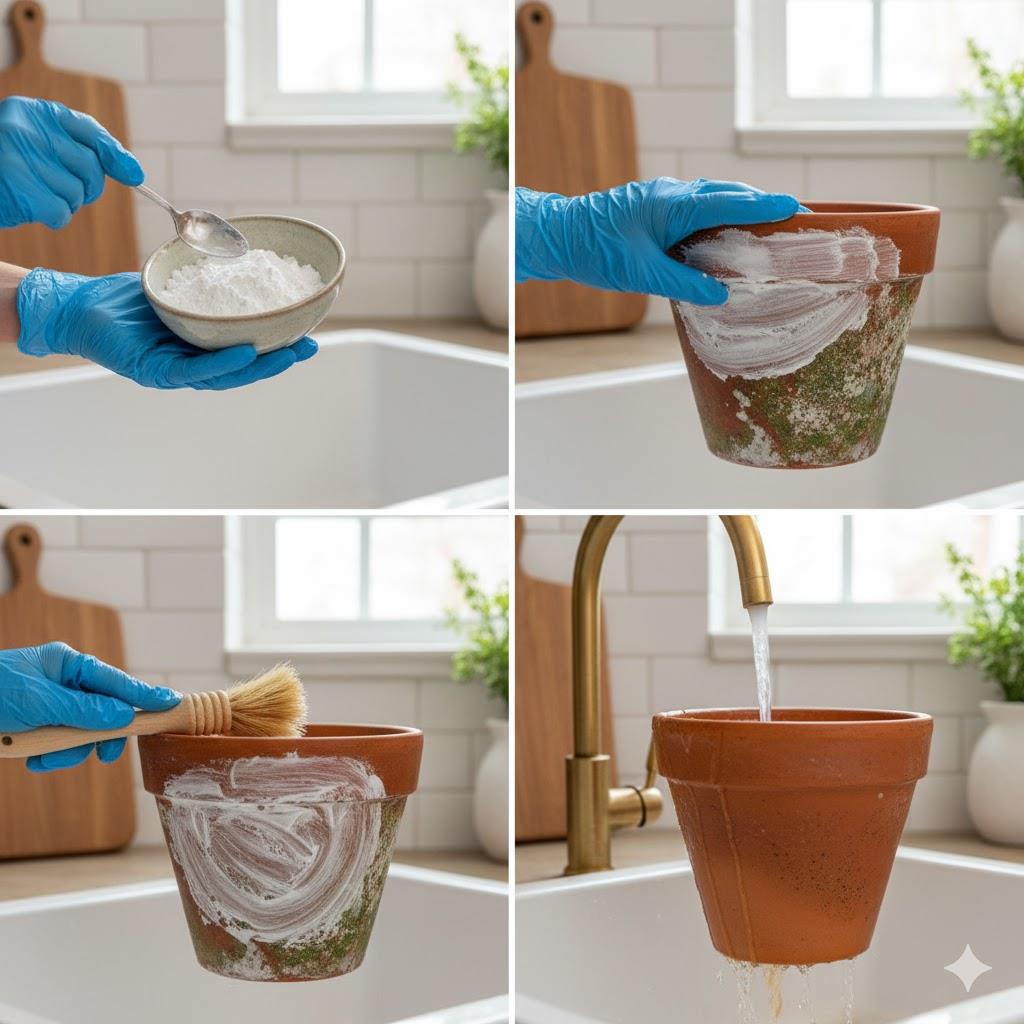
This method targets stubborn stains and oily deposits that cling to ceramic surfaces after repeated watering and soil contact.
- Mix baking soda with small amounts of warm water until you form a dense, spreadable paste. Apply a thin, even layer across brown marks, salt rings, and algae patches. This coating sinks into surface pits and prepares the stains for mechanical removal.
- Use a nylon brush and work in tight circular strokes. This action breaks the bond between the stain and the ceramic without scratching glazed or unglazed walls.
- Leave the paste on the surface for ten minutes. Wash away the paste and loosened particles. Warm water clears the surface clean and reveals any remaining spots.
- Repeat the paste on deeper discoloration because these areas hold older soil oils and mineral traces. A second pass often clears them fully.
Method 3: Pure vinegar

If your ceramic planters have dense mineral crust and old salt rings, you can ensure pure diluted solutions for cleaning off:
- Pour pure white vinegar directly onto the affected area. This high-acid contact breaks the outer layer of hardened mineral buildup fast.
- Press a vinegar-soaked microfiber cloth onto curved sections or vertical surfaces. This keeps the acid in place and prevents fast evaporation.
- Wait until the acid time reaches the mineral layer. As it sits, the crust softens and loosens from the ceramic surface.
- Work the area in circular strokes. This motion removes the softened crust without scratching glazed or unglazed sections.
- Flush the surface to clear vinegar, loosened mineral dust, and acidic residue. Warm water balances the surface and prevents sharp odor retention.
Note: Apply pure vinegar again on deeply embedded crust because these zones collect thick deposits. A second treatment often clears the surface completely.
What Not to Do When Cleaning Ceramic Planters?
Ceramic planters crack, stain, and weaken fast if you clean them the wrong way. You avoid several specific habits because each one damages the clay, the glaze, or the internal structure.
- Metal bristles scrape the glaze and scar raw clay. These scratches trap dirt and speed up mineral buildup in every cleaning cycle.
- Oven cleaners, bleach sprays, and chlorine gels eat into clay and leave chemical residues. These residues damage roots once you plant again.
- Pouring cold water on a warm planter creates micro-cracks that expand with time. This weakens both glazed and unglazed ceramic walls.
- Pressure jets strike rims and drainage holes with force and cause chips. These chips grow into fractures when the planter dries.
- Long vinegar exposure weakens unglazed clay and affects color. You only use controlled soak times to prevent structural stress.
- These tools create gouges that collect salts and grow deeper stains. Scraping also removes protective glazing in one stroke.
- Ceramic slips easily when wet. A fall on concrete cracks rims instantly. Work over a padded or rubber surface.
- Soap, vinegar, and baking soda leave residue that harms roots. Rinsing also restores the natural surface texture.
- Unglazed clay holds water deep inside. Planting too early traps excess moisture around fresh roots and encourages fungus.
How to Improve Drainage in Ceramic Planters?
1. Drill a Proper Drainage Hole
Drill a clean base hole using a masonry bit, and keep the drill at medium speed. As you hold the planter steady, guide the bit gently and create one direct exit channel for water.
2. Use a High-Aeration Potting Mix
Fill the planter with a mix that includes perlite, pumice, or coarse bark, and keep the ratios balanced. As you add each layer, create wide gaps so water moves downward without strain.
3. Add Aeration Material Throughout the Soil
Blend coarse sand or clay pellets into the entire potting mix, and break any tight clusters. As you mix thoroughly, create pathways that let water travel through every soil layer with ease.
4. Raise the Planter Off the Ground
Place the planter on pot feet or small risers, and lift the base slightly. As you set each foot, keep the drainage hole exposed so water drops straight out without touching the ground.
5. Use a Mesh Screen Instead of Rocks
Set a mesh screen over the drainage hole, and press it flat. As you position it, block soil from escaping but keep the opening clear so water passes through without slowing.
How Often Should You Clean Ceramic Planters?
You clean ceramic planters after every use because residue settles fast inside both glazed and unglazed walls. As you empty the pot, clear old soil and rinse the surface before minerals start bonding.
This prevents a hard crust from forming and stops algae from anchoring inside pores. You also protect the pot’s drainage performance because each cleaning clears fine particles that clog the lower soil layer and restrict water flow.
Seasonal Maintenance Tips for Ceramic Planters
Seasonal care keeps ceramic planters stable through heat, moisture, and cold. You manage each stage with simple adjustments that protect the clay and keep drainage consistent. Check for cracks often, and repair small chips with weatherproof adhesive. Use pots with drainage holes, and raise them on feet so water moves out fast.
In summer, shield glazed surfaces from harsh sun. In autumn, empty unused pots and clean them well. In winter, bring dry pots indoors or wrap outdoor ones so freeze–thaw cycles never stress the ceramic.
In Closing
Ceramic planters stay strong and visually clean when you remove residue, clear mineral buildup, maintain drainage, and adjust care through each season. Each step keeps the clay stable and protects both glazed and unglazed surfaces from long-term wear. With the right routine, every planter delivers better performance and lasts far longer in daily use.
For premium ceramic planters crafted with strict quality control, explore Dongsheng Ceramic and get custom or wholesale options designed for long-term durability.
Frequently Asked Questions
Question: Can ceramic planters absorb odors from old soil?
Answer: Yes. Unglazed ceramic absorbs organic residue and moisture, which creates persistent odors. Rinse the pot, soak it in equal parts warm water and vinegar, and dry it in open air to clear the trapped smell.
Question: Are ceramic planters safe for edible plants?
Answer: Yes, if they use food-safe glazes and lead-free firing processes. Choose planters from certified manufacturers to avoid glaze contaminants and maintain safe growing conditions for herbs and vegetables.
Question: Do ceramic planters need interior sealing?
Answer: Glazed planters do not need sealing because the coating blocks water absorption. Unglazed planters can use a breathable sealant only when you want slower moisture absorption without trapping water.
Question: Why do ceramic planters crack even with drainage holes?
Answer: Cracks form when moisture remains in the clay during freeze–thaw cycles or when the rim takes impact stress. Dry the pot fully in winter and lift it from the base to avoid fractures.
Question: Can I use ceramic planters without drainage holes indoors?
Answer: Yes, but use them as decorative cachepots. Place a plastic grower pot inside and drain excess water often. This keeps roots dry and prevents water buildup in the ceramic shell.
RECENT POSTS
- The Impact of Ceramic Materials in Energy-Efficient Buildings: Benefits and Applications
2025-12-04
- Top 7 Ceramic Cookware Health Benefits: Why It’s a Safer Choice for Your Kitchen
2025-12-04
- How to Clean Ceramic Planters and Improve Their Lifespan?
2025-11-17
- 15 Best Ceramic Holiday Gift Ideas for 2025: Thoughtful, Elegant & Heartfelt
2025-11-17
- Stoneware vs Porcelain vs Earthenware: Quick Decision Guide
2025-10-09
- Are Ceramic Glazes Food Safe? The Truth Behind the Shine
2025-10-09
- Christmas Decoration Trends That Wow Every Guest
2025-09-18
- Halloween Decoration Trending Ideas with Ceramics For 2025-26
2025-09-18










